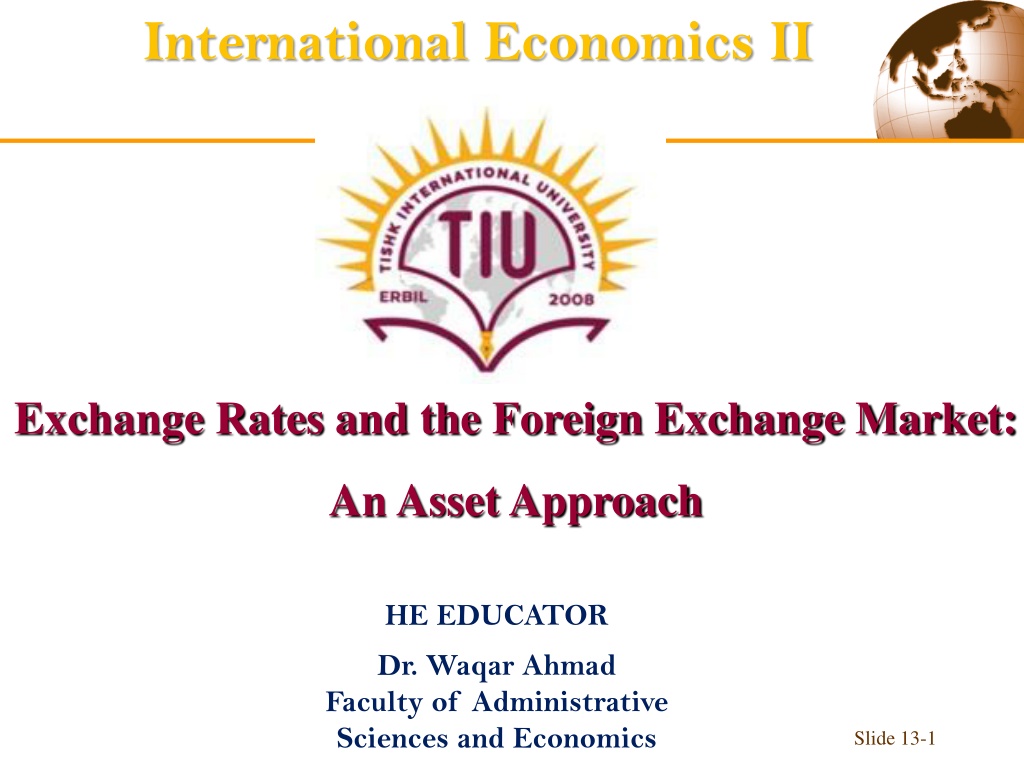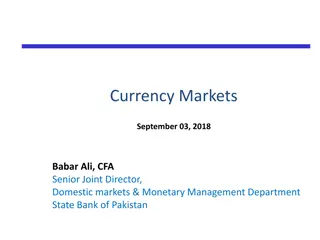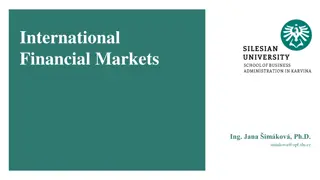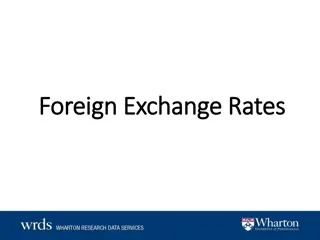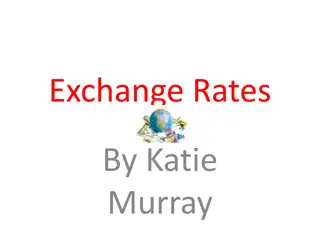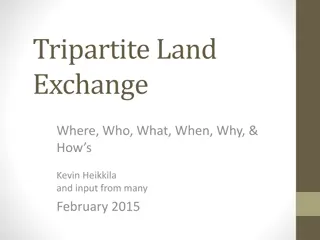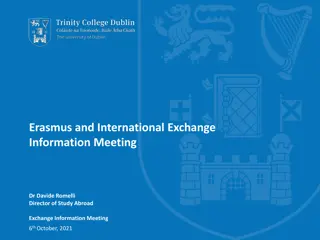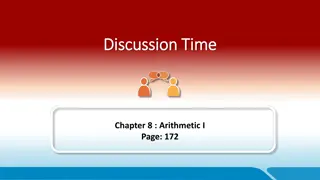Understanding Exchange Rates in International Economics
Exchange rates play a crucial role in translating prices between countries and impacting international trade. This chapter discusses how exchange rates are determined, their significance in global transactions, quoting methods, and the effects of currency appreciation and depreciation on relative prices of exports and imports.
Download Presentation

Please find below an Image/Link to download the presentation.
The content on the website is provided AS IS for your information and personal use only. It may not be sold, licensed, or shared on other websites without obtaining consent from the author. Download presentation by click this link. If you encounter any issues during the download, it is possible that the publisher has removed the file from their server.
E N D
Presentation Transcript
International Economics II Exchange Rates and the Foreign Exchange Market: An Asset Approach HE EDUCATOR Dr. Waqar Ahmad Faculty of Administrative Sciences and Economics Slide 13-1
Introduction Exchange rates are important because they enable us to translate different counties prices into comparable terms. Exchange rates are determined in the same way as other asset prices. The general goal of this chapter is to show: How exchange rates are determined The role of exchange rates in international trade Slide 13-2
Exchange Rates and International Transactions An exchange rate can be quoted in two ways: Direct The price of the foreign currency in terms of dollars Indirect The price of dollars in terms of the foreign currency Slide 13-3
Exchange Rates and International Transactions Table 13-1: Exchange Rate Quotations Slide 13-4
Exchange Rates and International Transactions Domestic and Foreign Prices If we know the exchange rate between two countries currencies, we can compute the price of one country s exports in terms of the other country s money. Example: The dollar price of a 50 sweater with a dollar exchange rate of $1.50 per pound is (1.50 $/ ) x ( 50) = $75. Slide 13-5
Exchange Rates and International Transactions Two types of changes in exchange rates: Depreciation of home country s currency A rise in the home currency prices of a foreign currency It makes home goods cheaper for foreigners and foreign goods more expensive for domestic residents. Appreciation of home country s currency A fall in the home price of a foreign currency It makes home goods more expensive for foreigners and foreign goods cheaper for domestic residents. Slide 13-6
Exchange Rates and International Transactions Exchange Rates and Relative Prices Import and export demands are influenced by relative prices. Appreciation of a country s currency: Raises the relative price of its exports Lowers the relative price of its imports Depreciation of a country s currency: Lowers the relative price of its exports Raises the relative price of its imports Slide 13-7 .
Exchange Rates and International Transactions Table 13-2: $/ Exchange Rates and the Relative Price of American Designer Jeans and British Sweaters Slide 13-8 .
The Foreign Exchange Market Exchange rates are determined in the foreign exchange market. The market in which international currency trades take place The Actors The major participants in the foreign exchange market are: Commercial banks International corporations Nonbank financial institutions Central banks Slide 13-9 .
Exchange Rates and International Transactions Interbank trading Foreign currency trading among banks It accounts for most of the activity in the foreign exchange market. Slide 13-10 .
Exchange Rates and International Transactions Characteristics of the Market The worldwide volume of foreign exchange trading is enormous, and it has ballooned in recent years. New technologies, such as Internet links, are used among the major foreign exchange trading centers (London, New York, Tokyo, Frankfurt, and Singapore). The integration of financial centers implies that there can be no significant arbitrage. The process of buying a currency cheap and selling it dear. Slide 13-11 .
Exchange Rates and International Transactions Vehicle currency A currency that is widely used to denominate international contracts made by parties who do not reside in the country that issues the vehicle currency. Example: In 2001, around 90% of transactions between banks involved exchanges of foreign currencies for U.S. dollars. Slide 13-12 .
Exchange Rates and International Transactions Spot Rates and Forward Rates Spot exchange rates Apply to exchange currencies on the spot Forward exchange rates Apply to exchange currencies on some future date at a prenegotiated exchange rate Forward and spot exchange rates, while not necessarily equal, do move closely together. Slide 13-13 .
Exchange Rates and International Transactions Figure 13-1: Dollar/Pound Spot and Forward Exchange Rates, 1981-2001 . Slide 13-14
Exchange Rates and International Transactions Foreign Exchange Swaps Spot sales of a currency combined with a forward repurchase of the currency. They make up a significant proportion of all foreign exchange trading. Slide 13-15 .
Exchange Rates and International Transactions Futures and Options Futures contract The buyer buys a promise that a specified amount of foreign currency will be delivered on a specified date in the future. Foreign exchange option The owner has the right to buy or sell a specified amount of foreign currency at a specified price at any time up to a specified expiration date. Slide 13-16 .
The Demand for Foreign Currency Assets The demand for a foreign currency bank deposit is influenced by the same considerations that influence the demand for any other asset. Assets and Asset Returns Defining Asset Returns The percentage increase in value an asset offers over some time period. The Real Rate of Return The rate of return computed by measuring asset values in terms of some broad representative basket of products that savers regularly purchase. Slide 13-17 .
The Demand for Foreign Currency Assets Risk and Liquidity Savers care about two main characteristics of an asset other than its return: Risk The variability it contributes to savers wealth Liquidity The ease with which it can be sold or exchanged for goods Slide 13-18 .
The Demand for Foreign Currency Assets Interest Rates Market participants need two pieces of information in order to compare returns on different deposits: How the money values of the deposits will change How exchange rates will change A currency s interest rate is the amount of that currency an individual can earn by lending a unit of the currency for a year. Example: At a dollar interest rate of 10% per year, the lender of $1 receives $1.10 at the end of the year. Slide 13-19 .
The Demand for Foreign Currency Assets Figure 13-2: Interest Rates on Dollar and Deutschemark Deposits, 1975-1998 . Slide 13-20
The Demand for Foreign Currency Assets Exchange Rates and Asset Returns The returns on deposits traded in the foreign exchange market depend on interest rates and expected exchange rate changes. In order to decide whether to buy a euro or a dollar deposit, one must calculate the dollar return on a euro deposit. Slide 13-21 .
The Demand for Foreign Currency Assets A Simple Rule The dollar rate of return on euro deposits is approximately the euro interest rate plus the rate of depreciation of the dollar against the euro. Therate of depreciationof thedollar against the euro is the percentage increase in the dollar/euro exchange rate over a year. Slide 13-22 .
The Demand for Foreign Currency Assets The expected rate of return difference between dollar and euro deposits is: R$- [R +(Ee$/ - E$/ )/E$/ ]= R$- R - (Ee$/ -E$/ )/E$/ (13-1) where: = interest rate on one-year dollar deposits = today s interest rate on one-year euro deposits R$ R E$/ = today s dollar/euro exchange rate (number of dollars per euro) Ee$/ = dollar/euro exchange rate (number of dollars per euro) expected to prevail a year from today Slide 13-23 .
The Demand for Foreign Currency Assets When the difference in Equation (13-1) is positive, dollar deposits yield the higher expected rate of return. When it is negative, euro deposits yield the higher expected rate of return. Slide 13-24 .
The Demand for Foreign Currency Assets Table 13-3: Comparing Dollar Rates of Return on Dollar and Euro Deposits . Slide 13-25
The Demand for Foreign Currency Assets Return, Risk, and Liquidity in the Foreign Exchange Market The demand for foreign currency assets depends not only on returns but on risk and liquidity. There is no consensus among economists about the importance of risk in the foreign exchange market. Most of the market participants that are influenced by liquidity factors are involved in international trade. Payments connected with international trade make up a very small fraction of total foreign exchange transactions. Therefore, we ignore the risk and liquidity motives for holding foreign currencies. Slide 13-26 .
Equilibrium in the Foreign Exchange Market Interest Parity: The Basic Equilibrium Condition The foreign exchange market is in equilibrium when deposits of all currencies offer the same expected rate of return. Interest parity condition The expected returns on deposits of any two currencies are equal when measured in the same currency. It implies that potential holders of foreign currency deposits view them all as equally desirable assets. The expected rates of return are equal when: R$= R +(Ee$/ - E$/ )/E$/ (13-2) Slide 13-27 .
Equilibrium in the Foreign Exchange Market How Changes in the Current Exchange Rate Affect Expected Returns Depreciation of a country s currency today lowers the expected domestic currency return on foreign currency deposits. Appreciation of the domestic currency today raises the domestic currency return expected of foreign currency deposits. Slide 13-28 .
Equilibrium in the Foreign Exchange Market Table 13-4: Today s Dollar/Euro Exchange Rate and the Expected Dollar Return on Euro Deposits When Ee$/ = $1.05 per Euro . Slide 13-29
Equilibrium in the Foreign Exchange Market Figure 13-3: The Relation Between the Current Dollar/Euro Exchange Rate and the Expected Dollar Return on Euro Deposits Today s dollar/euro exchange rate, E$/ 1.07 1.05 1.03 1.02 1.00 0.031 0.050 0.069 0.079 0.100 Expected dollar return on euro deposits, R + (Ee$/ - E$/ )/(E$/ ) . Slide 13-30
Equilibrium in the Foreign Exchange Market The Equilibrium Exchange Rate Exchange rates always adjust to maintain interest parity. Assume that the dollar interest rate R$, the euro interest rate R , and the expected future dollar/euro exchange rate Ee$/ , are all given. Slide 13-31 .
Equilibrium in the Foreign Exchange Market Figure 13-4: Determination of the Equilibrium Dollar/Euro Exchange Rate Exchange rate, E$/ Return on dollar deposits 2 E2$/ 1 E1$/ 3 E3$/ Expected return on euro deposits R$ Rates of return (in dollar terms) Slide 13-32 .
Interest Rates, Expectations, and Equilibrium The Effect of Changing Interest Rates on the Current Exchange Rate An increase in the interest rate paid on deposits of a currency causes that currency to appreciate against foreign currencies. A rise in dollar interest rates causes the dollar to appreciate against the euro. A rise in euro interest rates causes the dollar to depreciate against the euro. Slide 13-33 .
Interest Rates, Expectations, and Equilibrium Figure 13-5: Effect of a Rise in the Dollar Interest Rate Exchange rate, E$/ Dollar return 1 1' E1$/ E2$/ 2 Expected euro return R1$ R2$ Rates of return (in dollar terms) Slide 13-34 .
Interest Rates, Expectations, and Equilibrium Figure 13-6: Effect of a Rise in the Euro Interest Rate Exchange rate, E$/ Dollar return Rise in euro interest rate 2 E2$/ E1$/ 1 Expected euro return R$ Rates of return (in dollar terms) Slide 13-35 .
Interest Rates, Expectations, and Equilibrium The Effect of Changing Expectations on the Current Exchange Rate A rise in the expected future exchange rate causes a rise in the current exchange rate. A fall in the expected future exchange rate causes a fall in the current exchange rate. Slide 13-36 .
Summary Exchange rates play a role in spending decisions because they enable us to translate different countries prices into comparable terms. A depreciation (appreciation) of a country s currency against foreign currencies makes its exports cheaper (more expensive) and its imports more expensive (cheaper). Exchange rates are determined in the foreign exchange market. Slide 13-37 .
Summary An important category of foreign exchange trading is forward trading. The exchange rate is most appropriately thought of as being an asset price itself. The returns on deposits traded in the foreign exchange market depend on interest rates and expected exchange rate changes. Slide 13-38 .
Summary Equilibrium in the foreign exchange market requires interest parity. For given interest rates and a given expectation of the future exchange rate, the interest parity condition tells us the current equilibrium exchange rate. A rise in dollar (euro) interest rates causes the dollar to appreciate (depreciate) against the euro. Today s exchange rate is altered by changes in its expected future level. Slide 13-39 .
